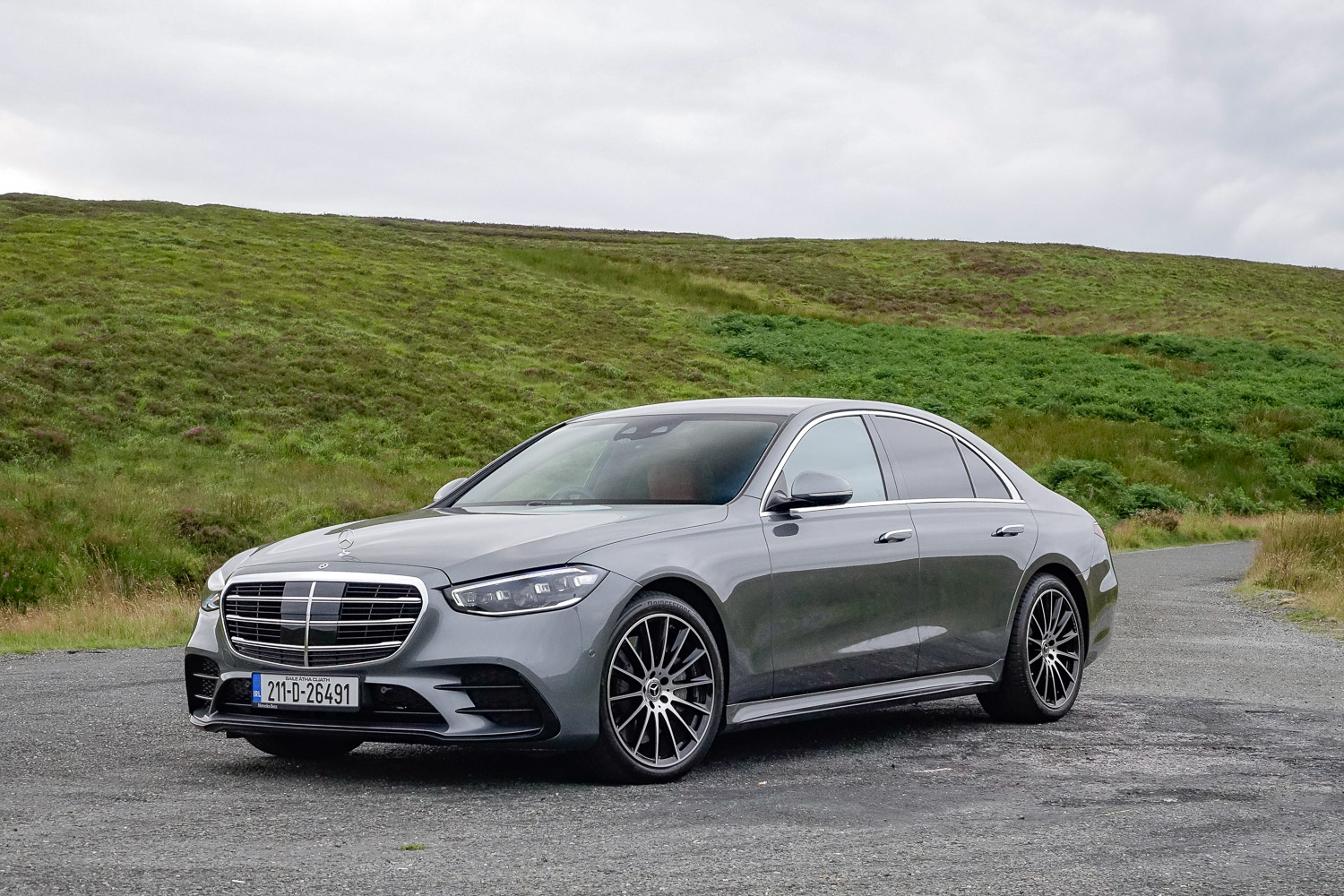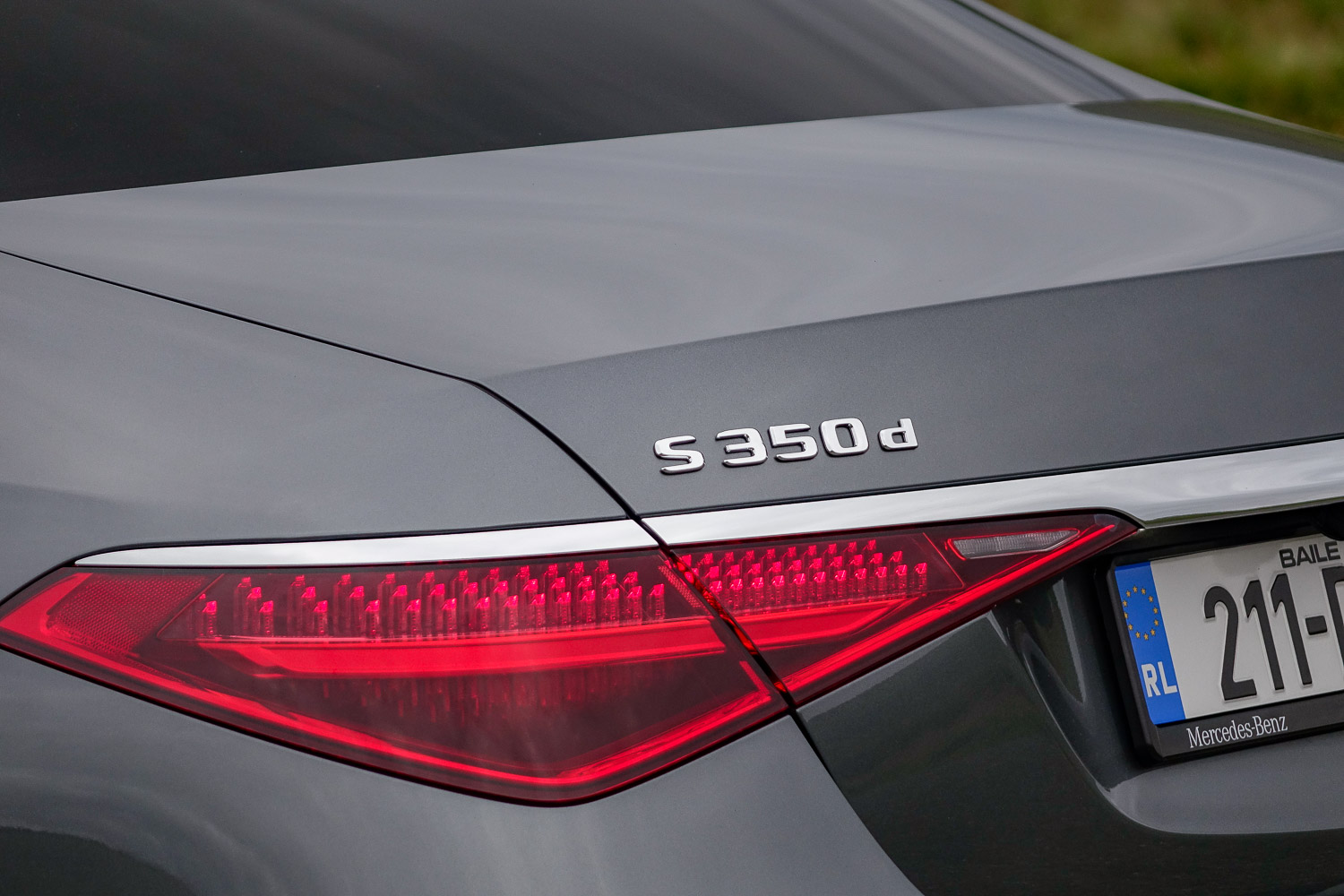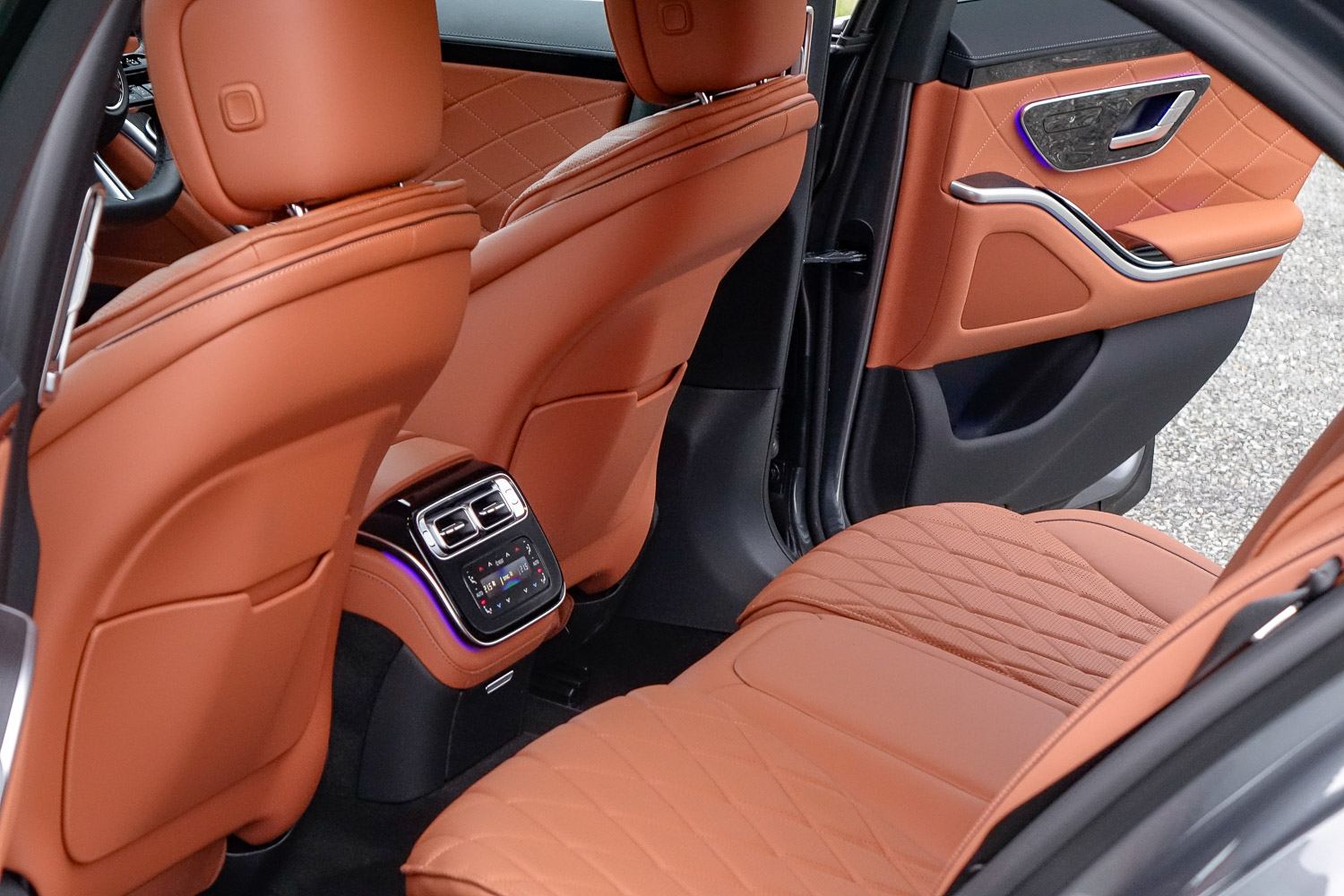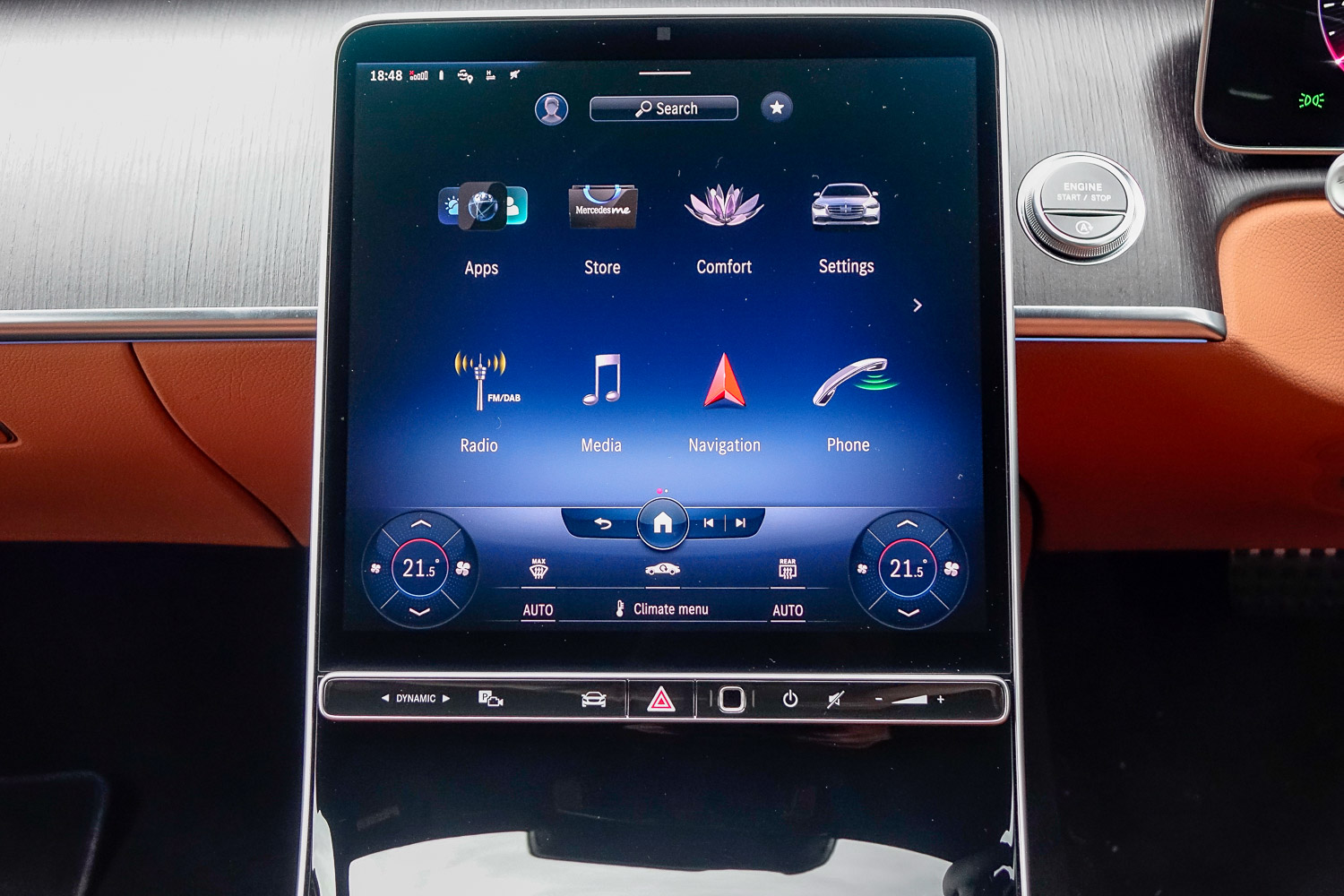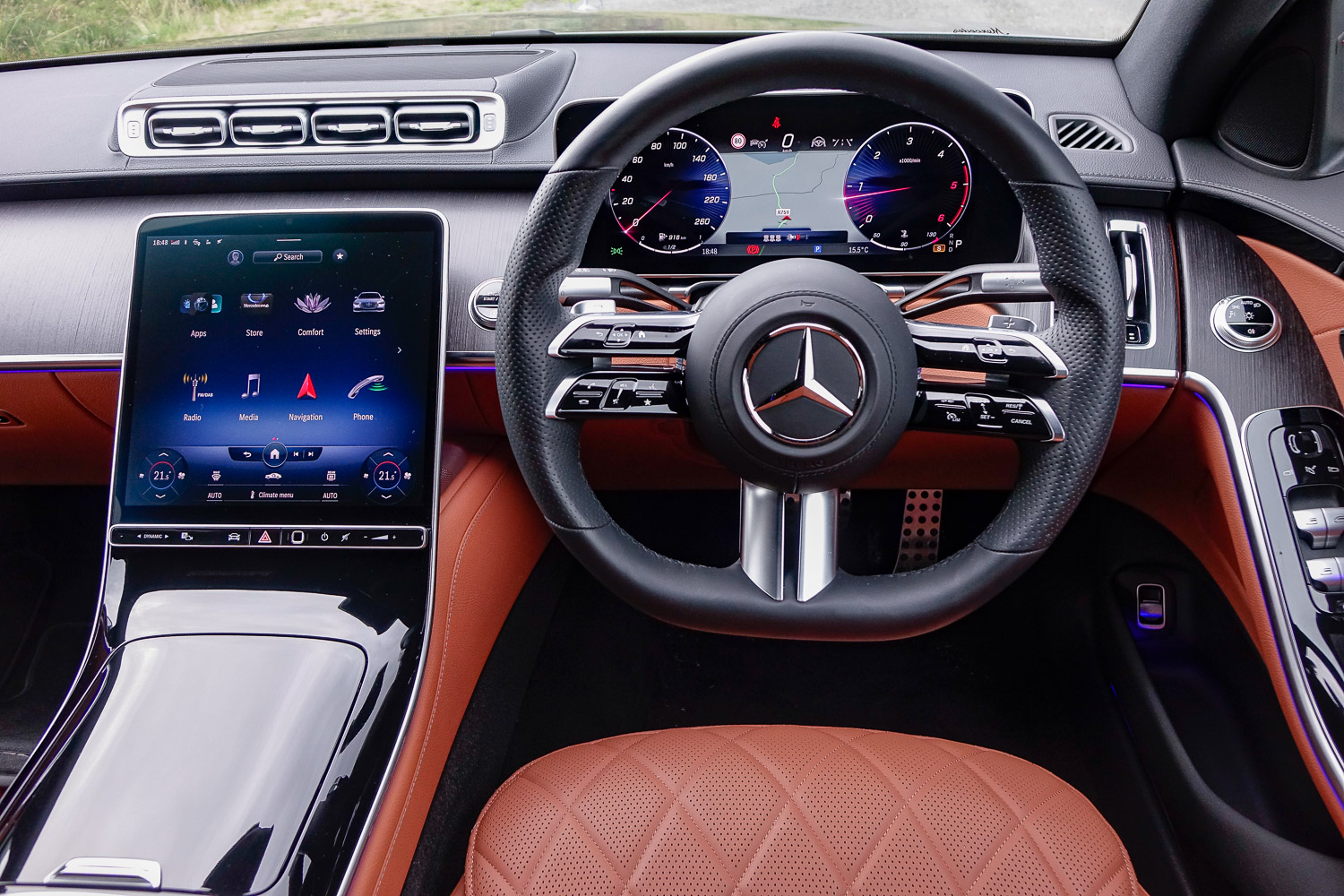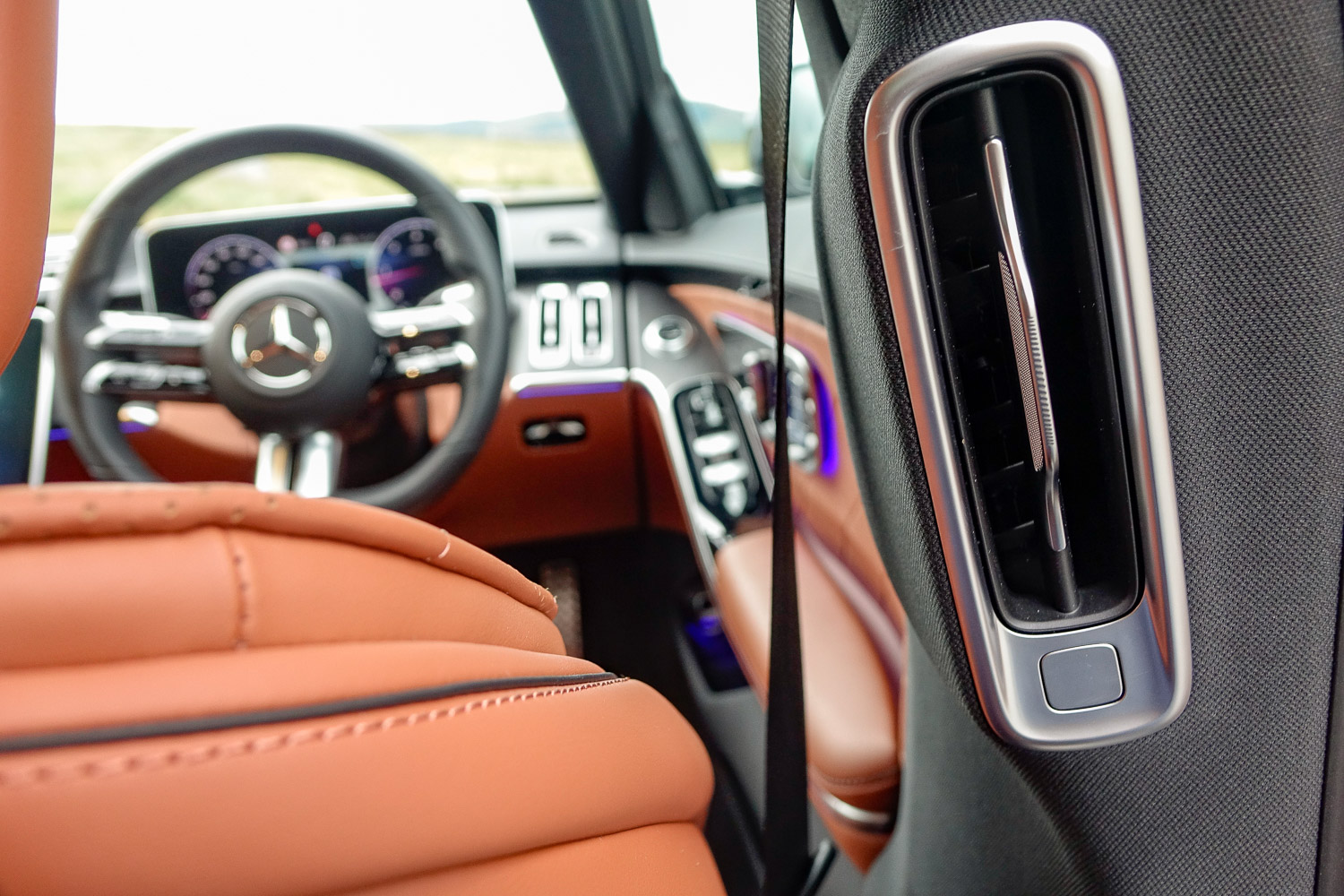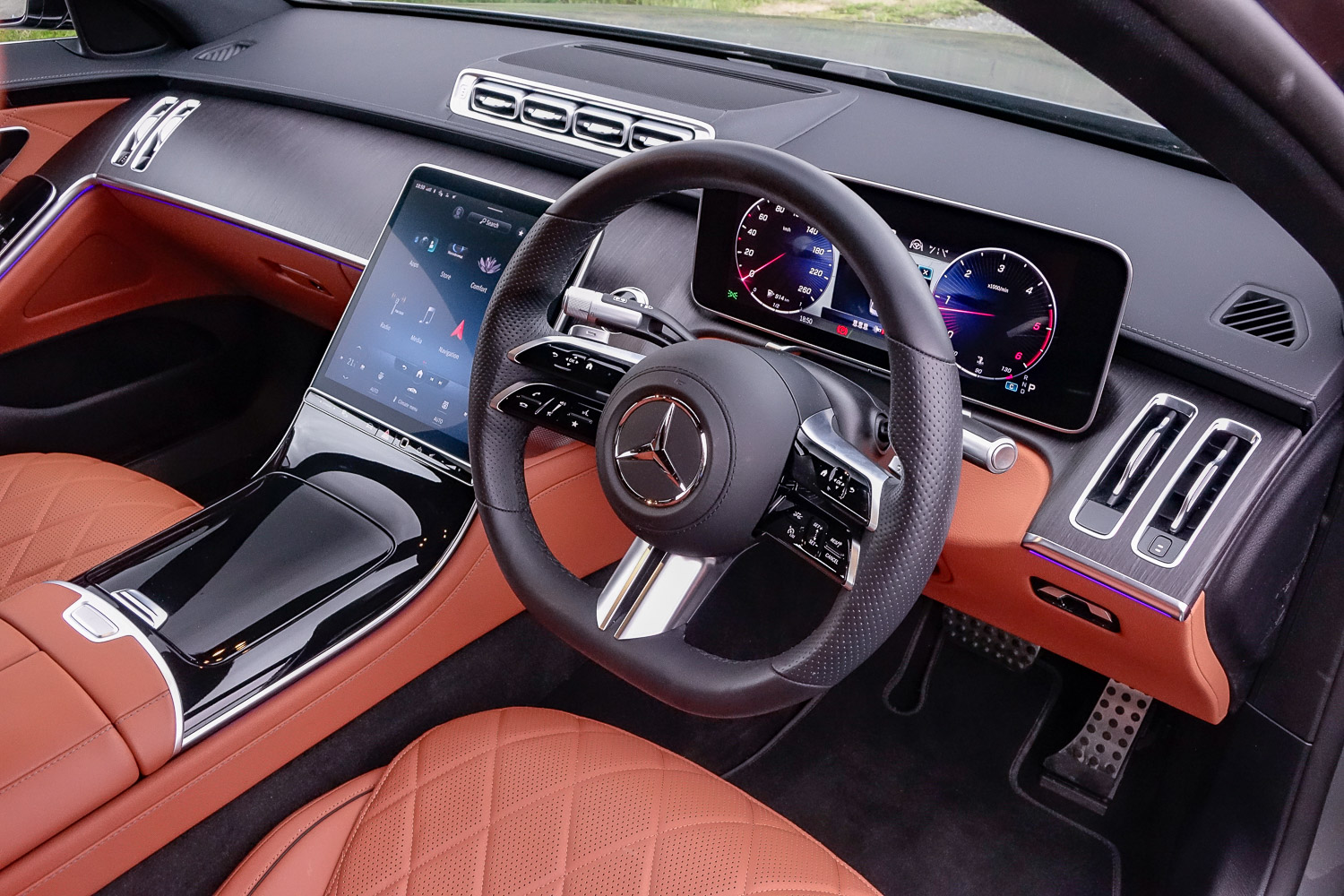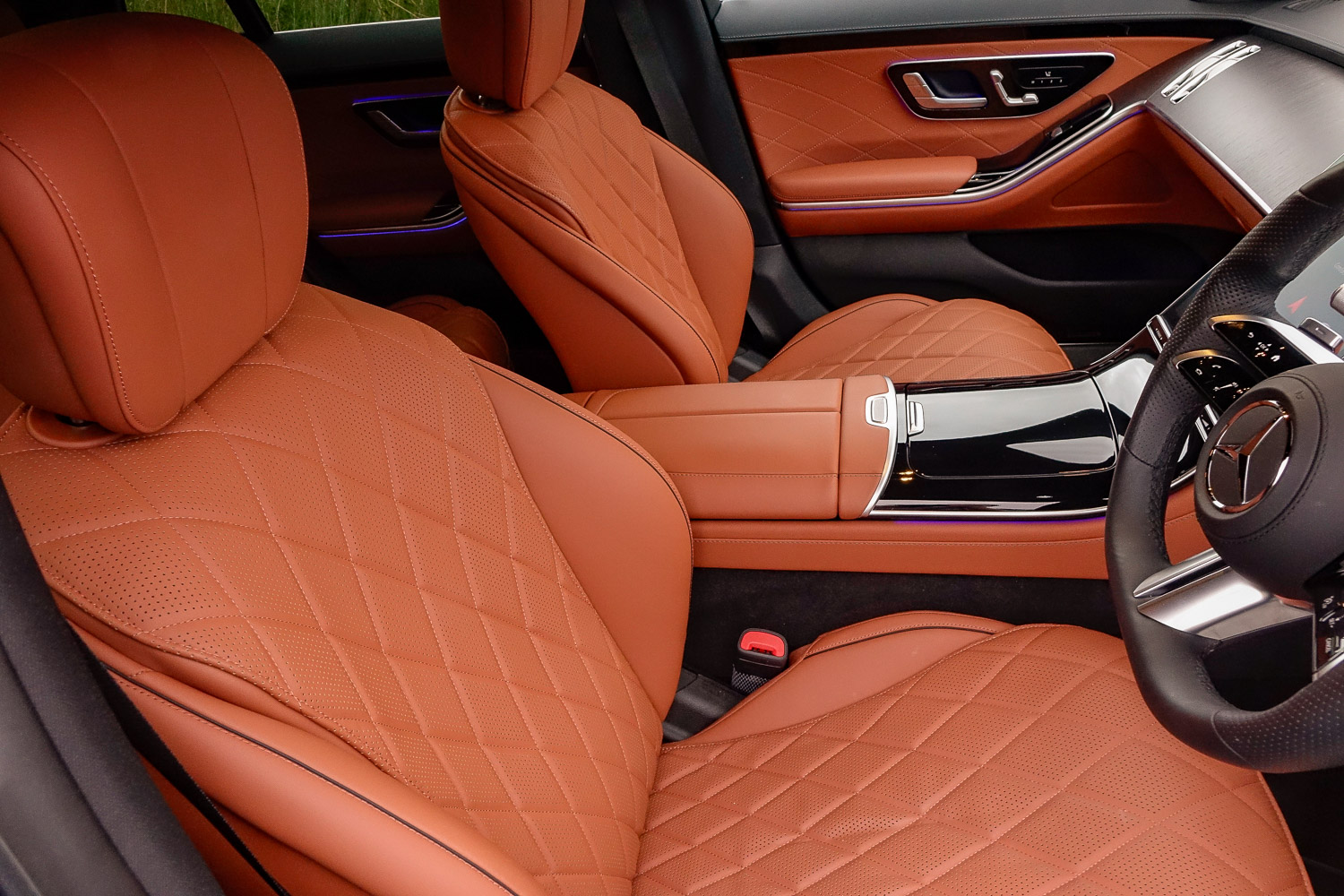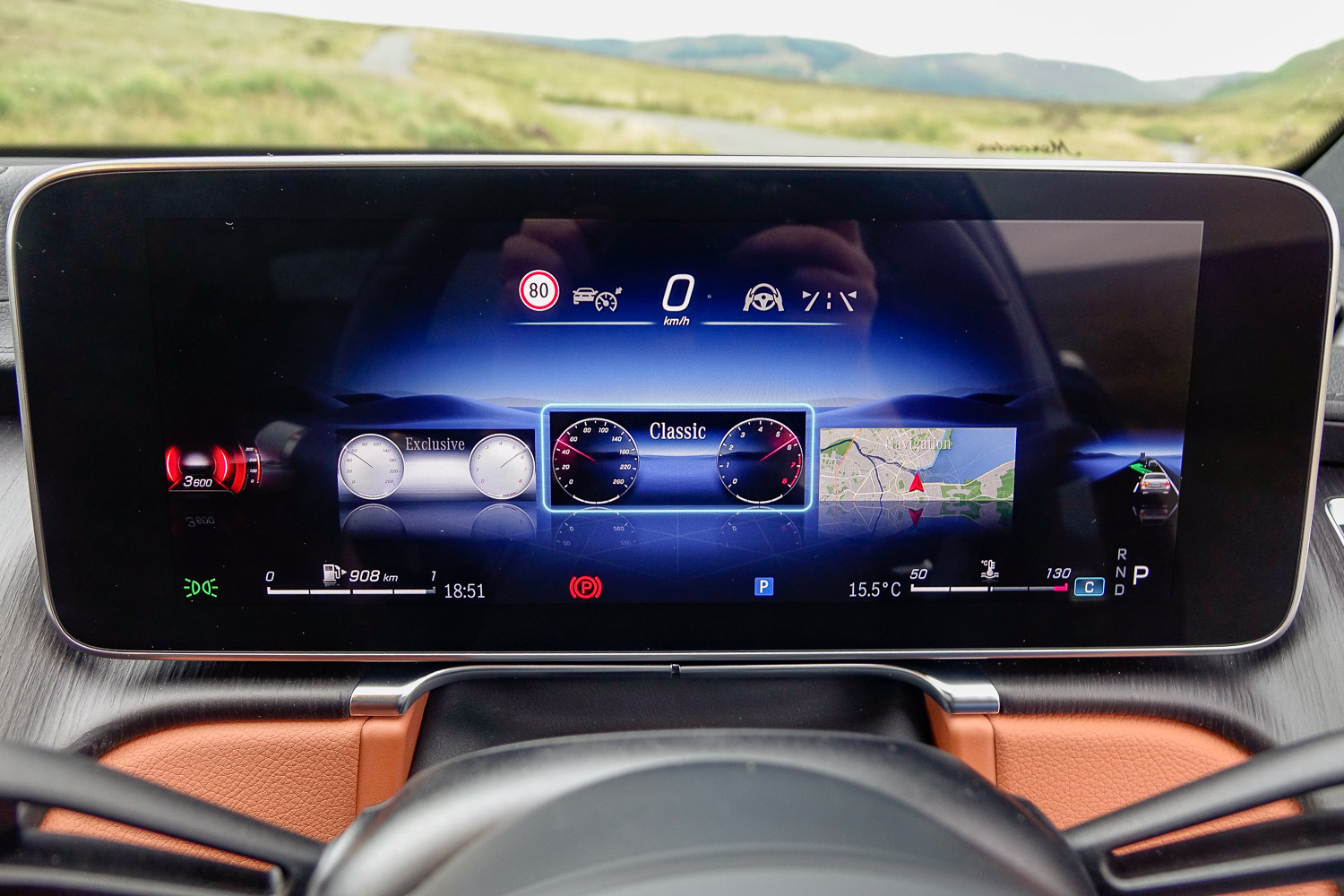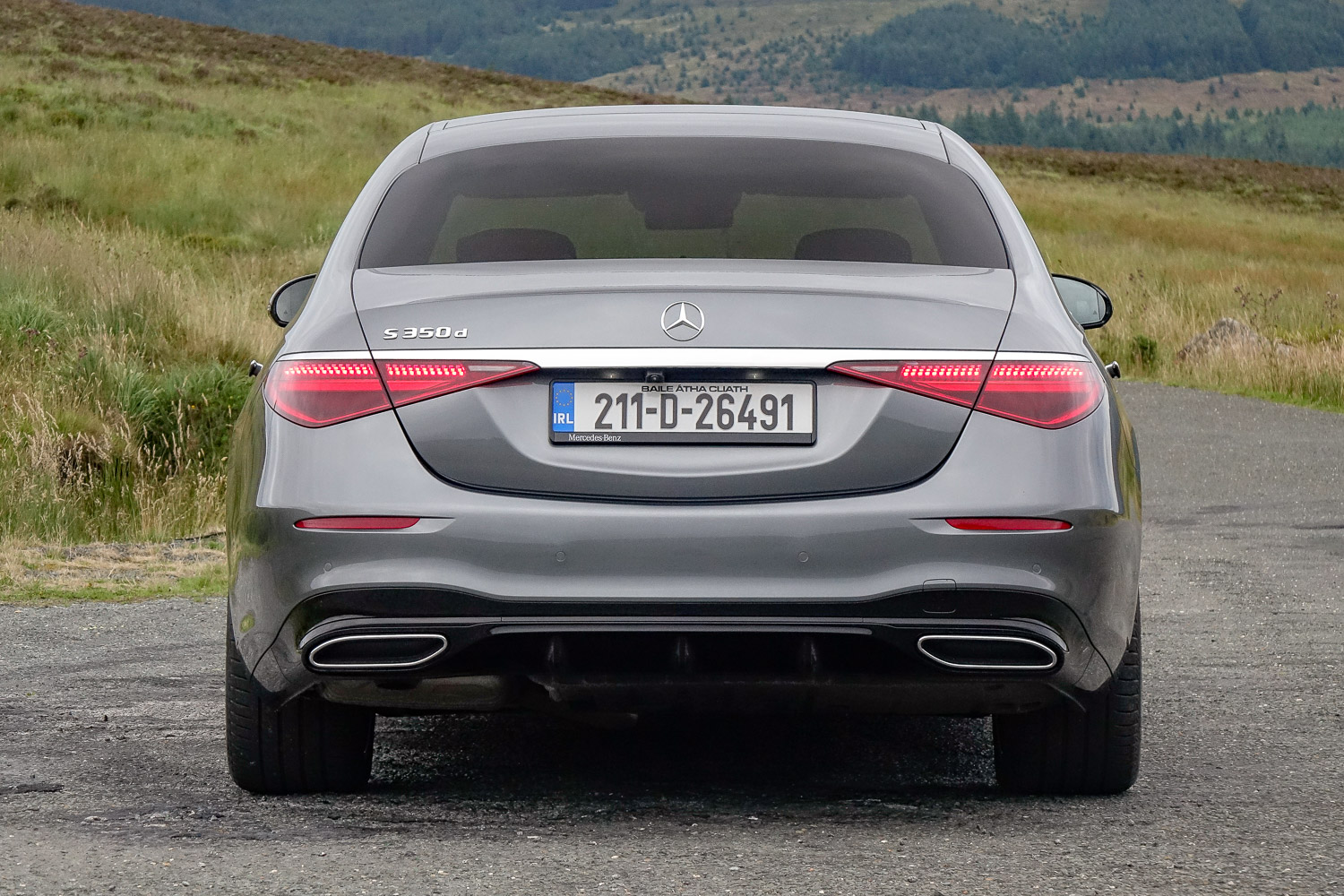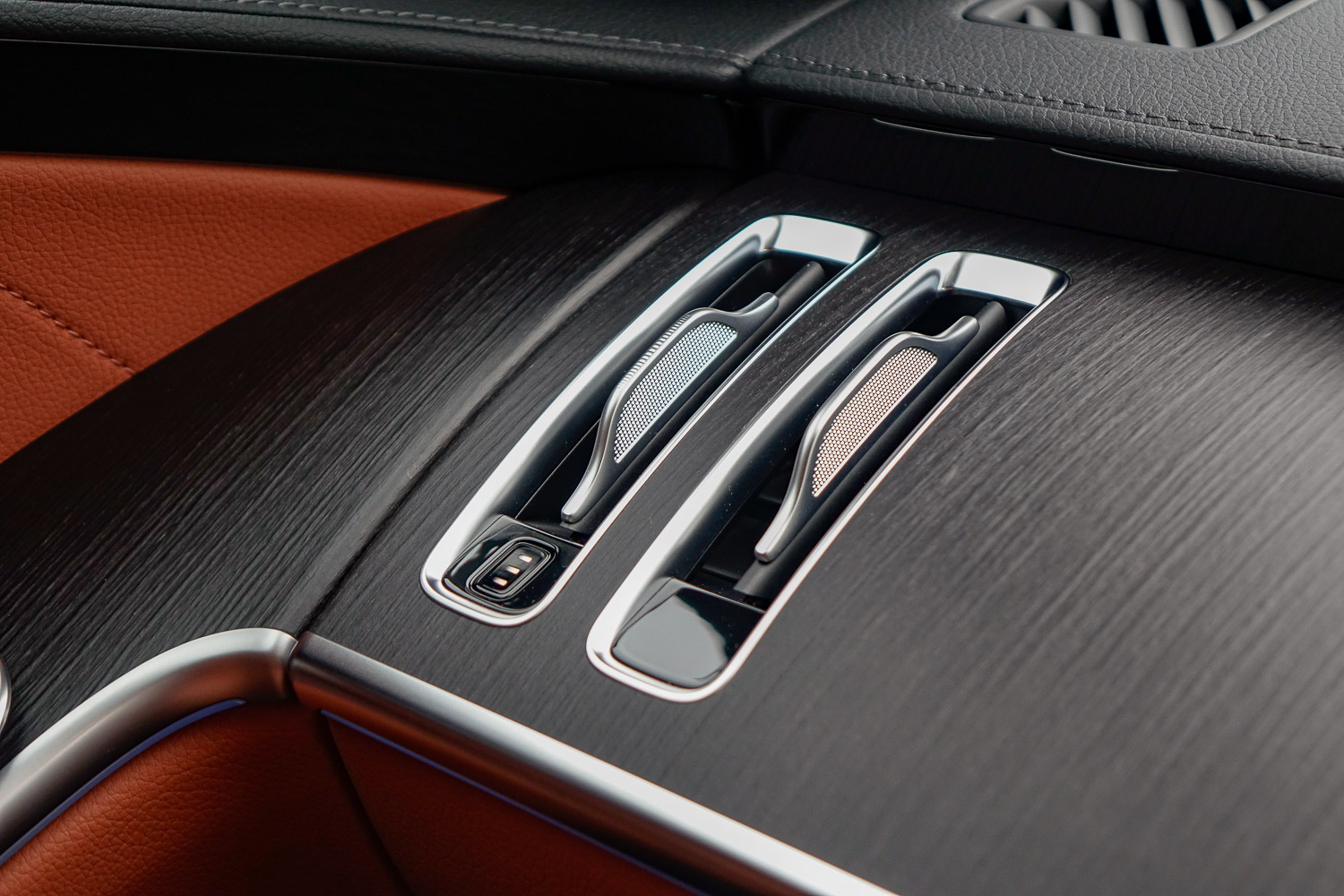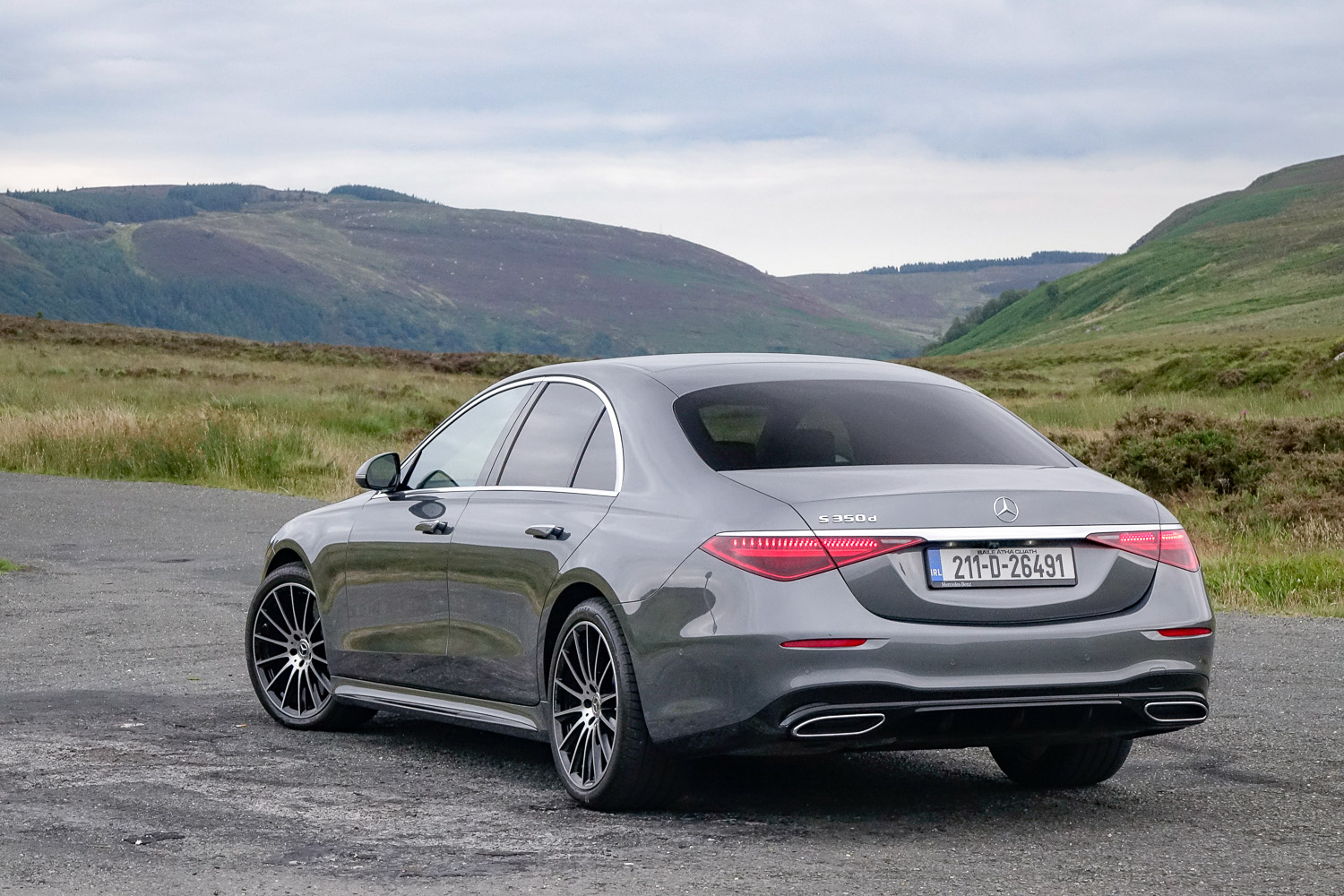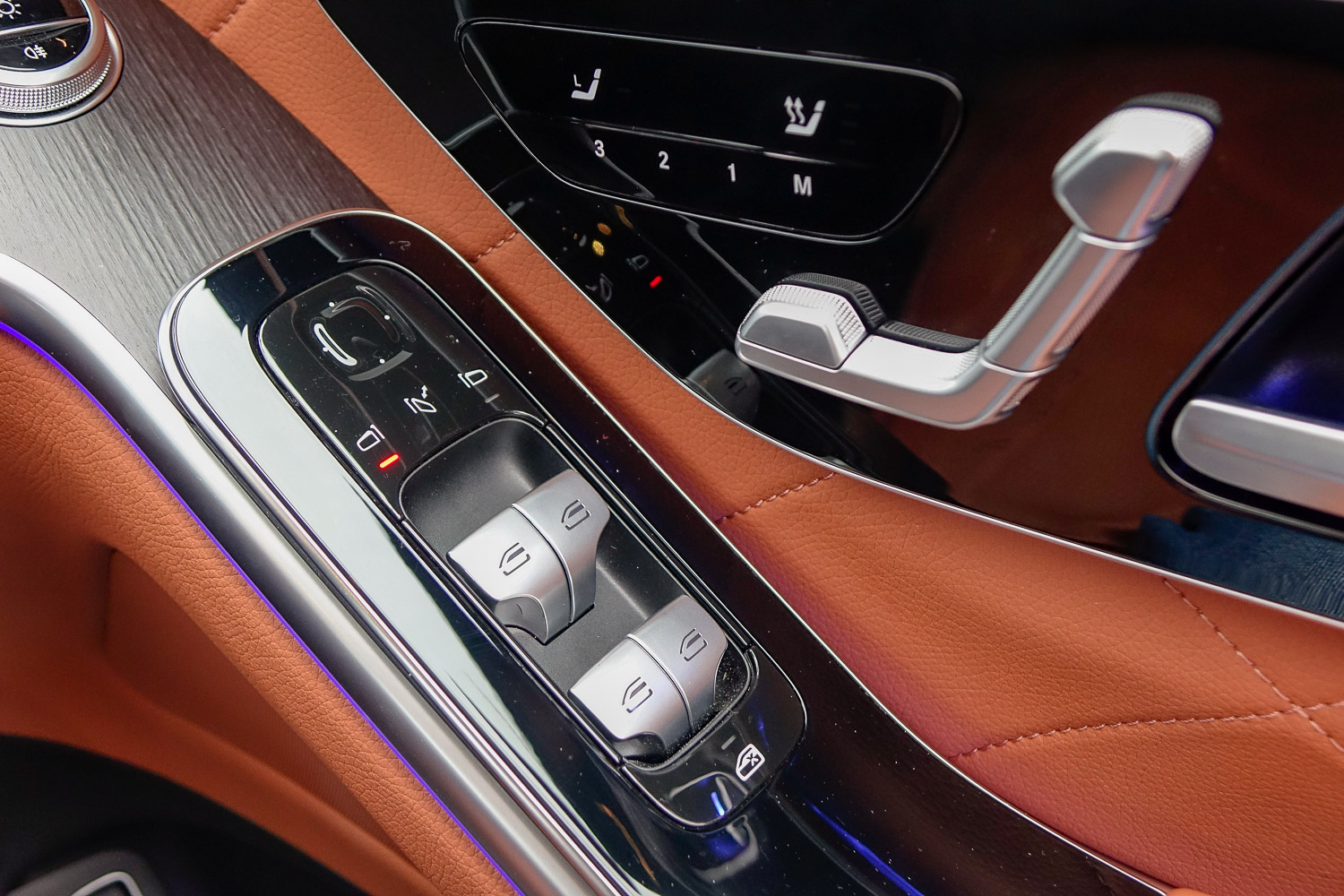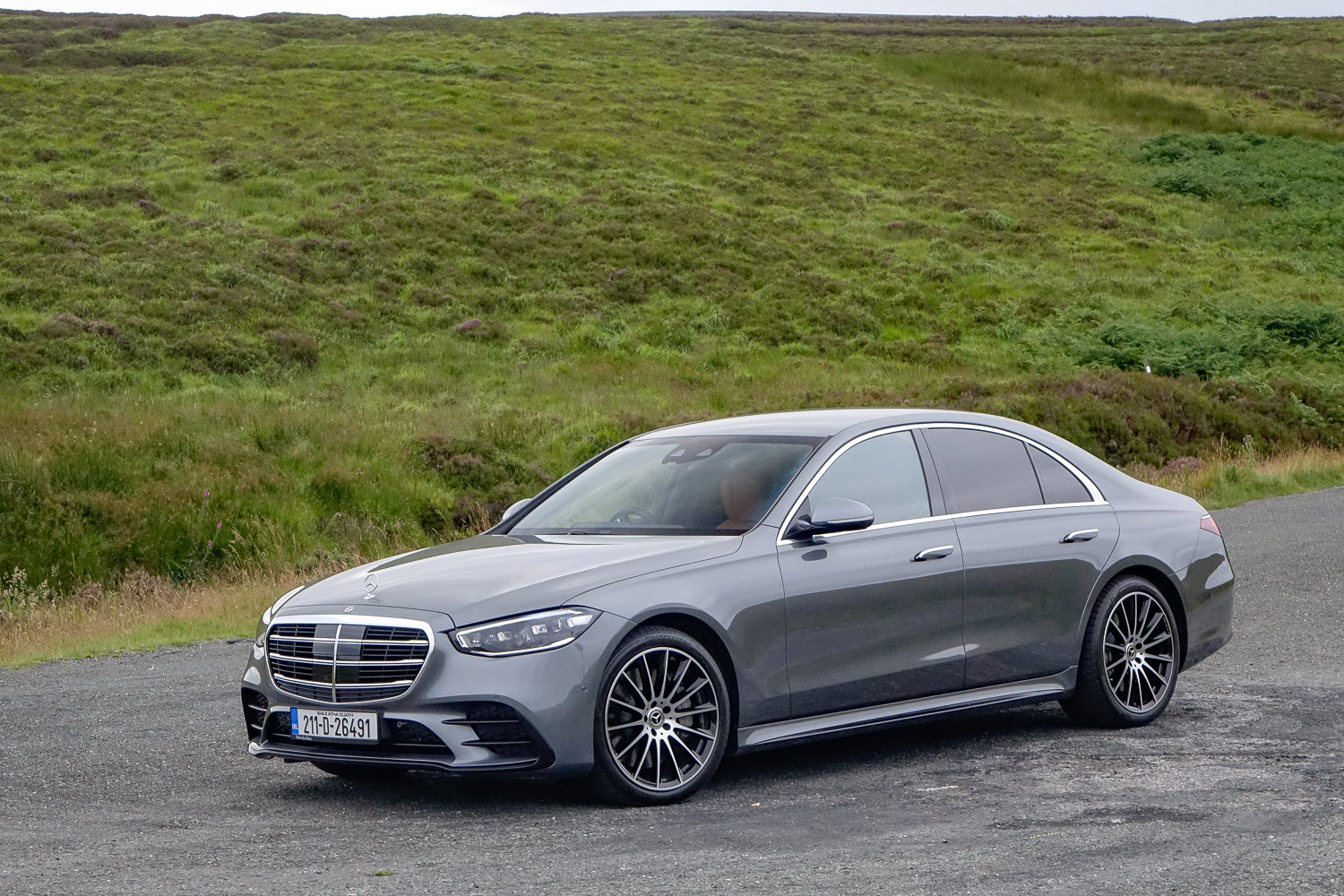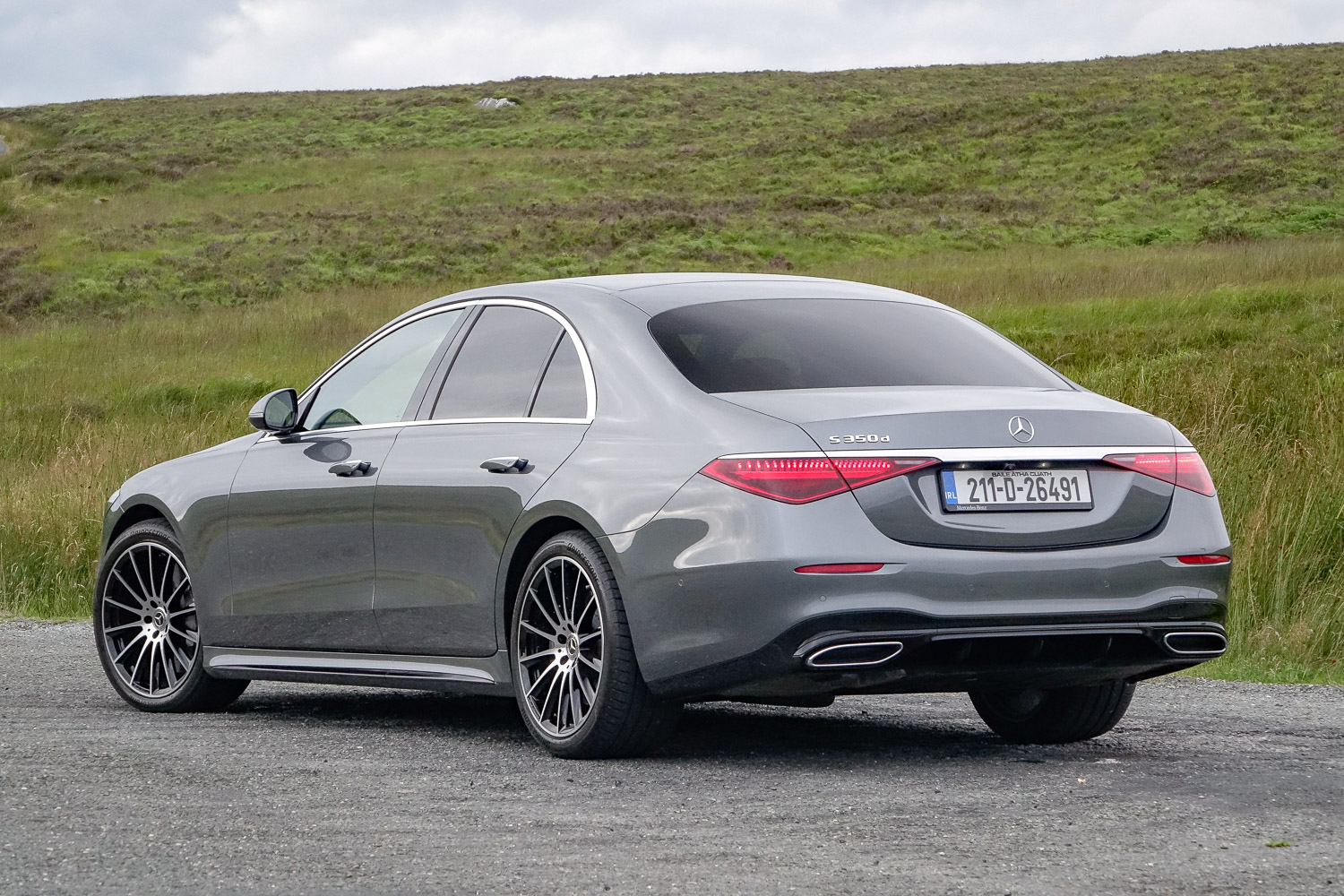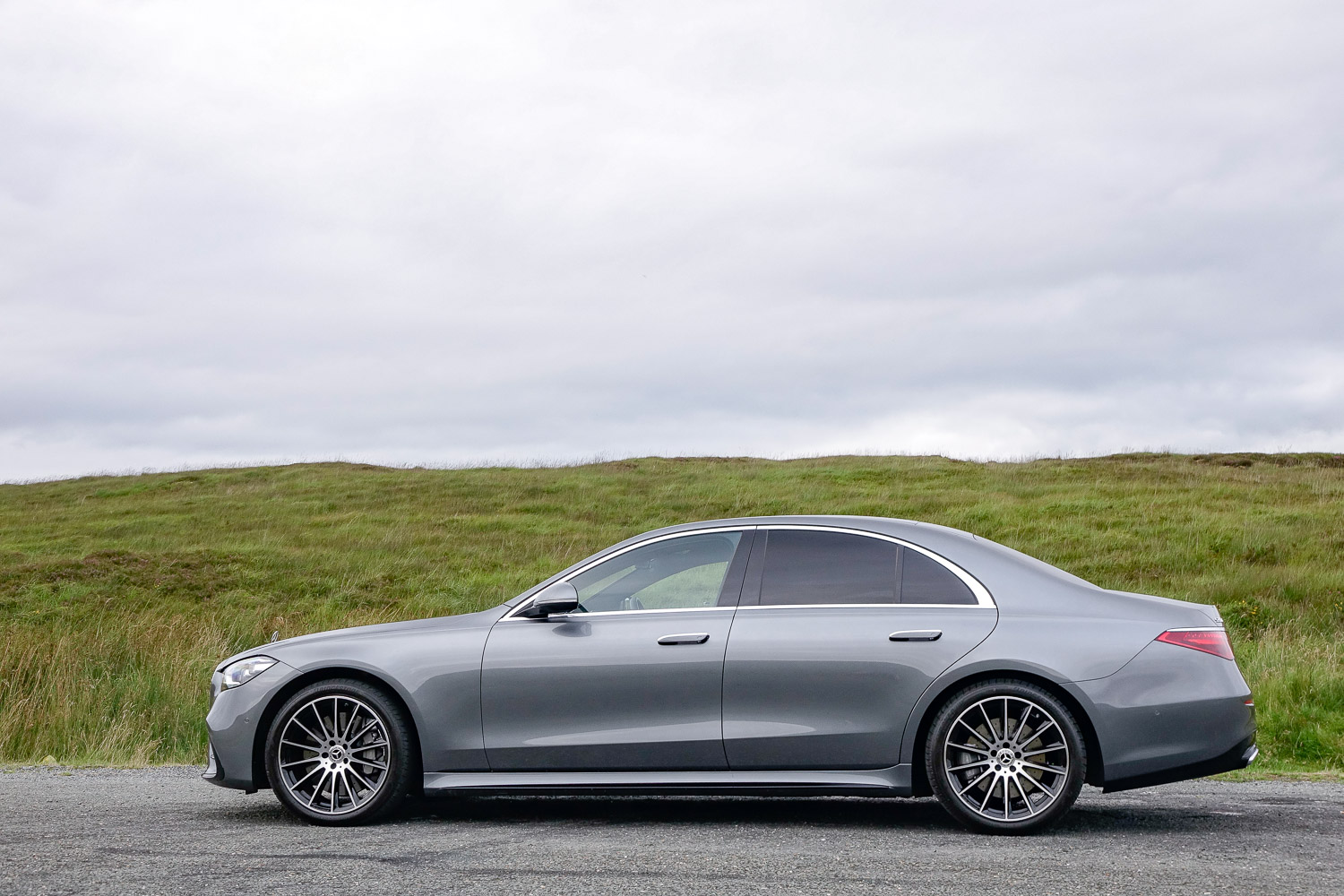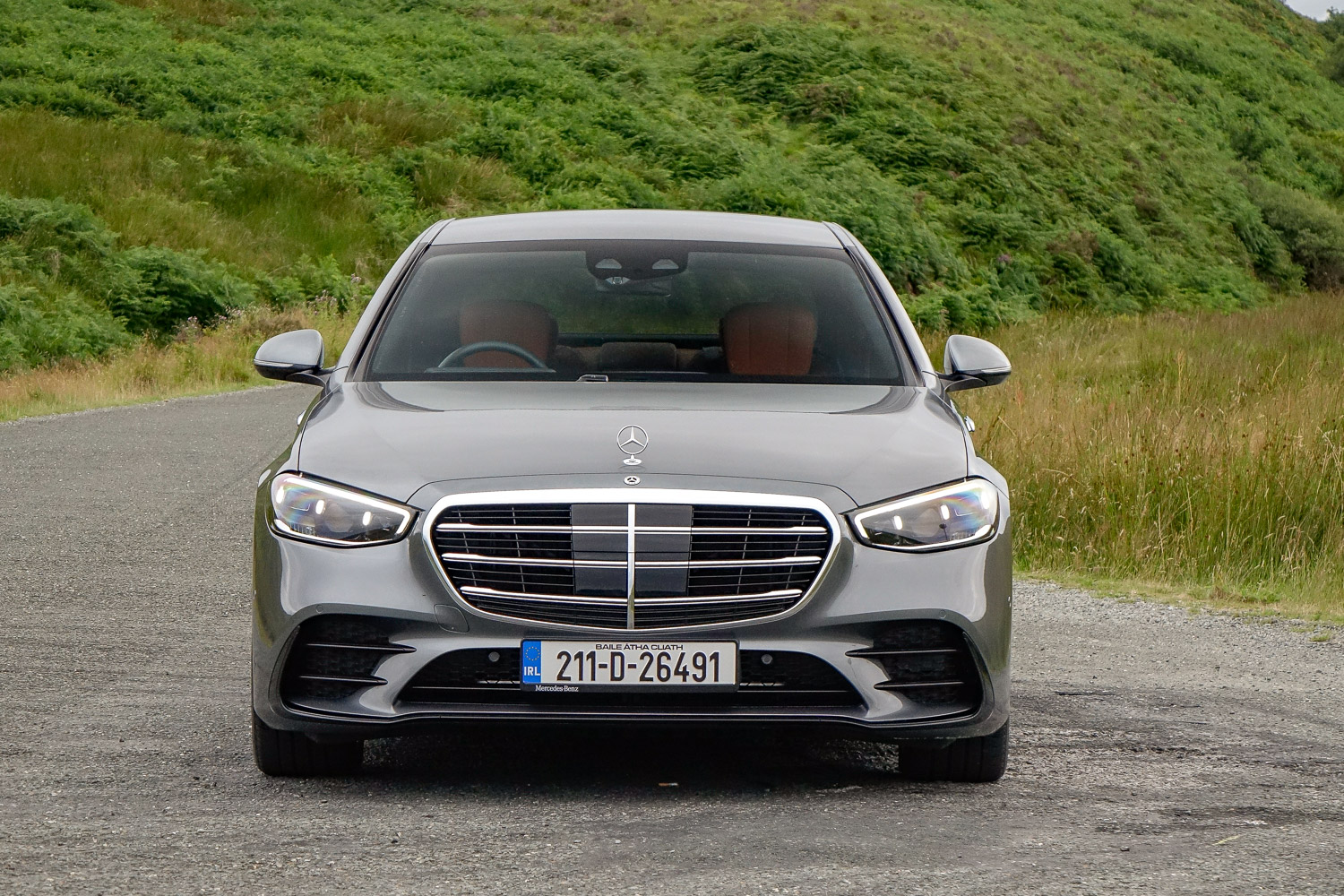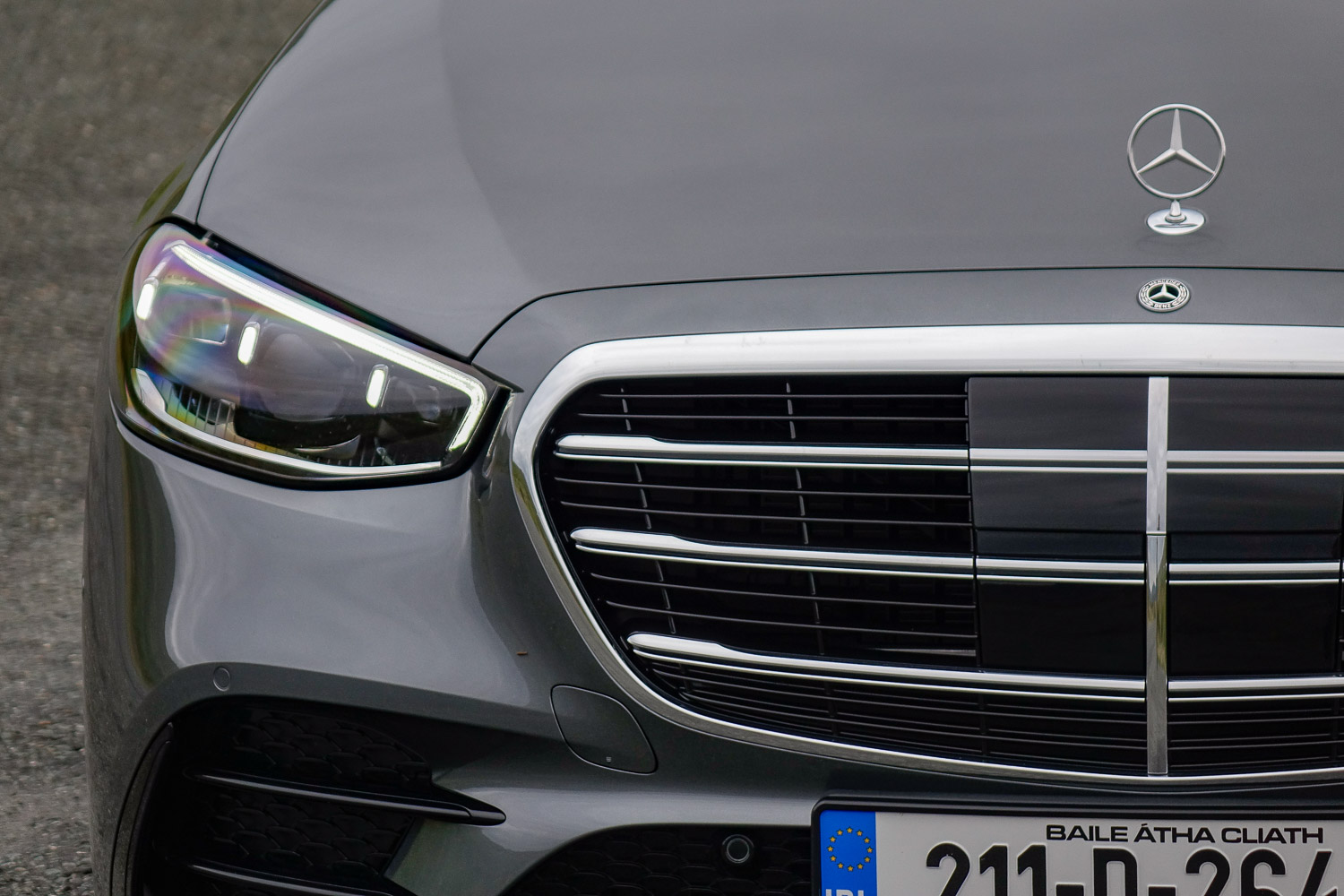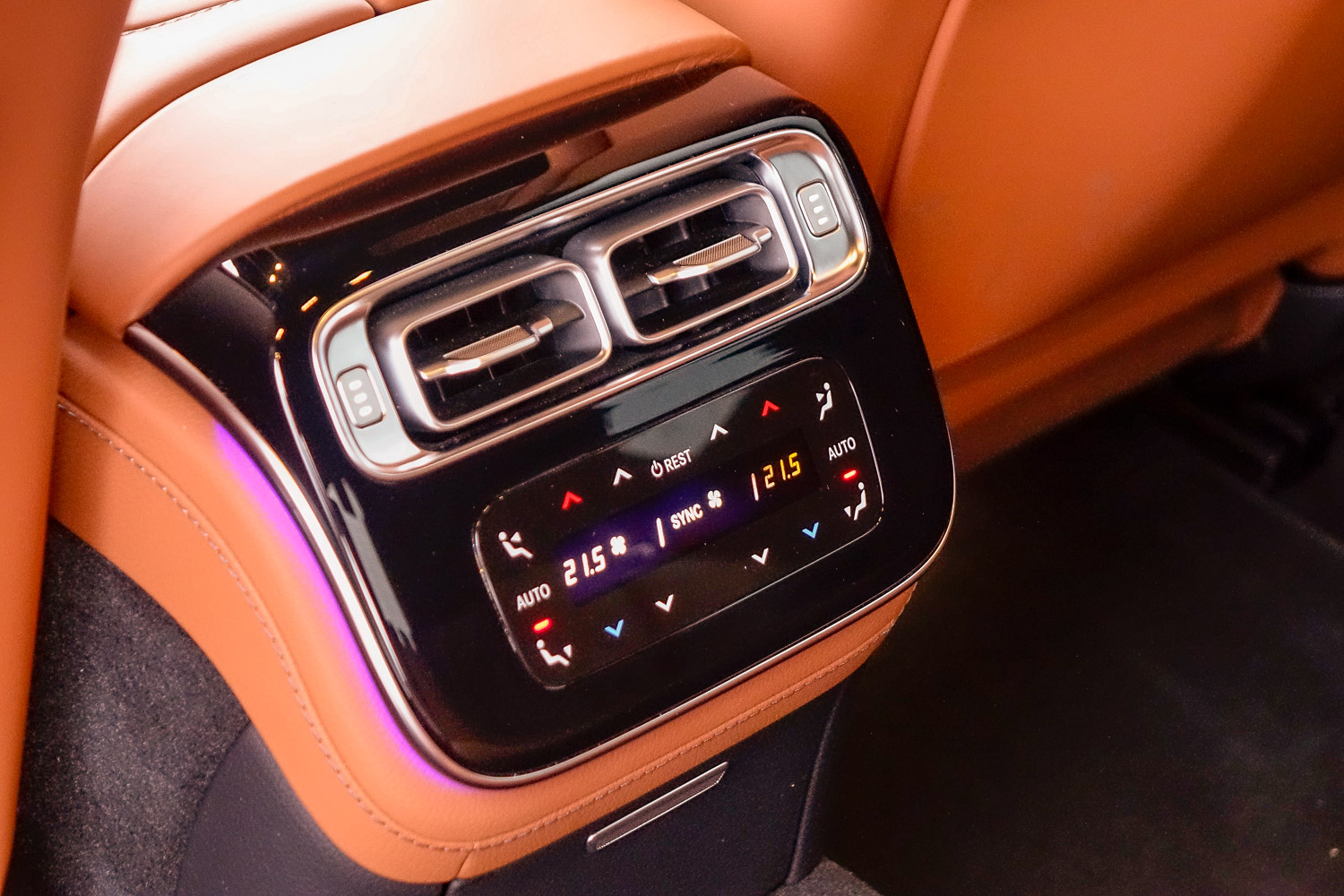Mercedes S-Class overview
We're on the seventh generation of the Mercedes-Benz S-Class now, codenamed W223. It's bigger in every direction than before and tech laden as ever. Buyers must pay extra for the headline-grabbing technology such as four-wheel steering, but the car is generously appointed by any other measure.
That's evidenced by our test car. It's the entry-level model, the rear-drive S 350 d AMG Line, and it is laden down with standard equipment. Mercedes Ireland upgraded the alloys and the leather, and added the Night Package, but that little lot adds less than €5,000 to the basic price. Most buyers spend more than that on options.
Although the luxury saloon market in Ireland is a relatively small one, there's fierce competition for the S-Class in the shapes of the Audi A8, BMW 7 Series and Lexus LS. Arguably, large SUVs also vie for buyers' attention - think BMW X7 and the Range Rover.
For now, it's still a market dominated by diesel power, though that does look set to change in the medium term. Will this be the last generation of the Mercedes S-Class that comes with a diesel engine? And is it still relevant in 2021?
The Mercedes S-Class model range
Irish pricing for the new S-Class starts at €123,875 and rises to €167,895. The S 350 d under test here can be had in long-wheelbase format, too. Both body styles can be paired with 4Matic four-wheel drive.
Using an uprated version of the same straight-six turbodiesel engine, making 330hp, is the S 400 d. That starts at €135,215 and comes with 4Matic by default. It can be had in standard and long-wheelbase formats, as well.
Three different petrol models are offered - the S 450, S 500 and S 580, putting out 367-, 435- and 503hp, respectively. These all get 4Matic as standard other than, oddly, the long-wheelbase variant of the S 450. That's the cheapest petrol model, at €133,415.
Interestingly, aside from the S 580, all other versions fall into the 171-190g/km CO2 band, costing €600 a year to tax.
The official Mercedes Ireland price list for the S-Class shows that all models are in AMG Line specification, which is generously equipped. As standard, there's a 12.8-inch OLED centre touchscreen, adaptive cruise control, air suspension, navigation, heated front and rear seats, keyless-go, reversing camera, climate control front and rear, smartphone integration, wireless charging pad and the AMG styling inside and out. There are plenty of expensive options and upgrade packs to consider as well, of course.
Mercedes Ireland provided an example of PCP finance for the S-Class on its Star Finance scheme. On a total purchase price of €125,375, the monthly repayments came out as €1,521 on an APR of 4.9 per cent over three years - following a 30 per cent deposit. Go to the Star Finance PCP section of the Mercedes website to look into that further.
We expect the S-Class range to expand further in time, including full-on Mercedes-AMG variants, along with plug-in hybrid models.
The Mercedes S-Class interior
The cabin of the new S-Class is exceptional, mixing tactile materials with high quality and cutting-edge technology. It's not quite perfect, but it's not far off.
In the driver's door you'll find a large rotary controller for the lights, along with the usual Mercedes way to adjust the seats - with a seat-shaped set of controls. Like many items in the car, these are now touch-sensitive instead of movable buttons and, to be honest, we prefer the old way of doing it. Same story for the mirror adjustment switchgear.
A dark textured material links the door panel to the dashboard, where there are two large upright air vents either side. Most of the dash is covered in an expanse of this material, which looks great. Up high in the middle is a set of four rectangular air vents, which also look good. We'd have expected them to be a little more solid in operation, though.
In front of the driver is a three-spoke steering wheel with a flattened bottom. It feels of high quality, though, as we've said before of the latest generation of capacitive Mercedes steering wheels, the touch sliders etc. are tricky to use accurately on the move.
Ahead of the wheel is a relatively compact screen for the instrumentation. The layout can be changed and it's of high resolution. Of course, the central touchscreen is the big talking point here. It's an OLED display, sloped back, and it looks stunning. It works well too, with crisp operation and a well laid out menu system.
Although the climate control must be operated via the screen, at least it's always visible so you don't have to press another button before it appears. There's a supplementary button bar running along the bottom of the screen allowing access to the driving mode, volume control and even a fingerprint reader.
We really like how the screen smoothly integrates with the shiny black section of the centre console. Under that you'll find a wireless charging pad and USB ports, along with the cupholders. Behind that, under the armrest, is a large storage cubby.
The bright orangey-brown Vienna leather upholstery pictured here is optional - more restrained hues are available. It's a lovely soft luxurious material.
Though we didn't test the long-wheelbase model, the rear seats of the regular S-Class are arguably as important as those up front. They're exceptionally comfortable, though the seats have no adjustment as standard. They are heated, however, and there's a control panel in the back for the climate control, too, with vents in the middle and near the doors. Under the central vents there's a covered storage section with another USB port.
Despite a large transmission tunnel, it is possible to fit three adults in the back, but obviously it's optimised for two and the doors open wide to make it easy to get in and out. A beautifully damped centre armrest drops down and has lots of storage in it.
The boot opens electrically and holds a useful 540 litres.
In comparison to key rivals, the S-Class's use of space is superior to that of the Audi A8 and its large OLED touchscreen dates that and the BMW 7 Series. The sense of luxury and attention to detail compares well with the interior of the Lexus LS, too. Indeed, the Mercedes cabin stands up well to appraisal next to the likes of the Bentley Flying Spur as well, which is considerably more expensive to buy.
The Mercedes S-Class driving experience
There's lots of adjustment of the steering wheel and driver's seat to suit all shapes, sizes and seating position preferences - it's easy to get comfortable. We're not convinced by the idea of a flat-bottomed steering wheel in a luxury saloon, but at least its leather rim is good to hold. The driver selector is on the right and there are small gearchange paddles mounted to the back of the wheel.
They're all but redundant thanks to the combination of the torque-rich diesel engine and the excellent nine-speed automatic gearbox. While the engine is never completely inaudible, you don't need to extend it very far to make meaningful progress, either. If you do rev it out, it rewards with a cultured straight-six sound in the distance. We would like it to be a smidgen quieter at slow speeds, however. No complaints about the transmission, though, which changes gear almost imperceptibly, regardless of driving mode.
We found little reason to change out of the default setting, either. There, the gearbox calibration cleverly uses the engine's torque rather than unnecessarily changing down when you ask for brisk acceleration. Naturally, it will drop a gear or two if you press the accelerator all the way down to the kick-down switch, but there's rarely a need for that.
While the engine isn't silent at slow speeds, other exterior noises are, which you'll notice if you drive across a gravel drive, for example - the 'scrunch' is difficult to hear from inside the car. That translates into fantastic road noise suppression on the move, though rougher motorway surfaces do inevitably cause a little more tyre roar.
On the motorway, the S-Class is sublime. Wind noise is appreciably low, and the car is incredibly stable. For part of our motorway test, we drove through streaming rain, and it felt utterly composed. What's more, the adaptive cruise control worked perfectly in those conditions, even in heavy traffic, taking the load off the driver and reducing strain.
Over three hours at motorway speeds, the average fuel consumption came out at 7.1 litres/100km, which is quite close to the official figure. Perhaps of more importance to those that don't wish to spend much time on the forecourt, the S 350 d can travel well over 1,000km between fill-ups.
All of the above is enough to cement the S-Class's position in the segment, but it also manages to be an enjoyable car to drive on more interesting roads. The adaptive damping and air suspension work well even over difficult surfaces allowing the S-Class to maintain its speed. The steering is good and the whole car shrinks around you for the most part - its considerable width is noticeable on narrow lanes. The rear-drive chassis allows for great balance and even agility through a sequence of corners. It's quite astounding that Mercedes has managed to marry that driver involvement with the long-distance cruising ability expected of a limousine such as this.
Alternatives to the Mercedes S 350 d
As mentioned above, direct competitors to the S-Class in the luxury saloon segment include the Audi A8, BMW 7 Series and Lexus LS. The Audi A8 50 TDI, which comes as standard with quattro four-wheel drive, is much cheaper than the S-Class in SE guise, or a little more expensive in high-spec Luxury trim. We reckon the Mercedes eclipses the Audi in terms of design and the driving experience, though.
The BMW 7 Series looks to be better value, again, as even the (much more powerful) 740d, with xDrive all-wheel drive and the M Sport specification undercuts the S 350 d. The 730d is much cheaper, over €20,000 less at the bottom of the diesel 7 Series ladder, in fact. The Mercedes has the preferable cabin and exterior design, but it doesn't drive any better.
Conversely, the Lexus LS is only available as the 500h model, powered by a 3.5-litre V6-based hybrid system, so it's unlikely to be considered by someone that needs the long-distance economy of a diesel. For the record, the LS 500h starts at over €150,000.
For the record, the BMW X7 xDrive40d M Sport costs about €135,000 and it's just as luxurious as the S-Class, with a much larger and more practical cabin and boot. More performance, too, and all-weather traction. The Range Rover, powered by a 300hp diesel, starts at about the same price.
Our verdict on the Mercedes S-Class
The new Mercedes S-Class is undoubtedly a contender for top spot in the sector, though it's expensive when compared with most of its rivals. Nonetheless, it looks good outside and in, it's luxurious, crammed with technology and it's even good to drive. The diesel-fuelled S 350 d is still all the luxury car most people need, though if long-distance economy is not a priority, buyers have plenty of petrol options in the line-up - and they will be even more refined. Or they can wait for the S 580 e plug-in hybrid.

